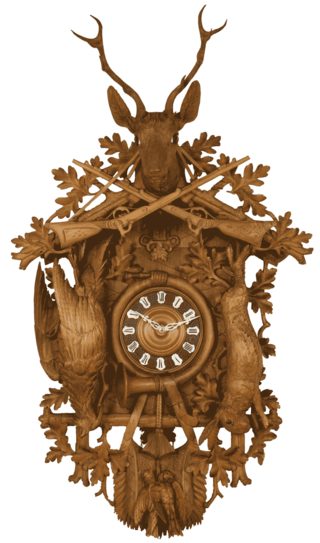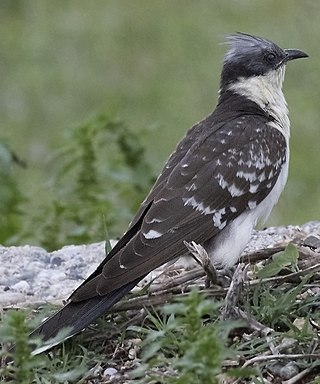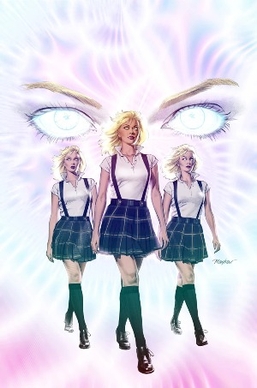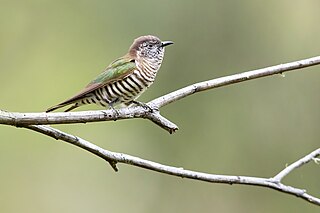
Cuckoos are birds in the Cuculidae family, the sole taxon in the order Cuculiformes. The cuckoo family includes the common or European cuckoo, roadrunners, koels, malkohas, couas, coucals, and anis. The coucals and anis are sometimes separated as distinct families, the Centropodidae and Crotophagidae, respectively. The cuckoo order Cuculiformes is one of three that make up the Otidimorphae, the other two being the turacos and the bustards. The family Cuculidae contains 150 species, which are divided into 33 genera.

The common cuckoo is a member of the cuckoo order of birds, Cuculiformes, which includes the roadrunners, the anis and the coucals.

The cuckoo-roller or courol is the only bird in the family Leptosomidae, which was previously often placed in the order Coraciiformes but is now placed in its own order Leptosomiformes. The cuckoo-roller is at the root of a group that contains the Trogoniformes, Bucerotiformes, Piciformes, and Coraciiformes. Despite its name, the Cuckoo-roller does not share close evolutionary origins with cuckoos or rollers at all.

A cuckoo clock is a type of clock, typically pendulum driven, that strikes the hours with a sound like a common cuckoo call and has an automated cuckoo bird that moves with each note. Some move their wings and open and close their beaks while leaning forwards, whereas others have only the bird's body leaning forward. The mechanism to produce the cuckoo call has been in use since the middle of the 18th century and has remained almost without variation.

The black-billed cuckoo is a New World species in the Cuculidae (cuckoo) family. The scientific name is from Ancient Greek. The genus name, kokkuzo, means to call like a common cuckoo, and erythropthalmus is from eruthros, "red" and ophthalmos, "eye".

The yellow-billed cuckoo is a member of the cuckoo family. Common folk names for this bird in the southern United States are rain crow and storm crow. These likely refer to the bird's habit of calling on hot days, often presaging rain or thunderstorms. The genus name is from the Ancient Greek kokkuzo, which means to call like a common cuckoo, and americanus means "of America".

The great spotted cuckoo is a member of the cuckoo order of birds, the Cuculiformes, which also includes the roadrunners, the anis and the coucals.

The Jacobin cuckoo, also pied cuckoo or pied crested cuckoo, is a member of the cuckoo order of birds that is found in Africa and Asia. It is partially migratory and in India, it has been considered a harbinger of the monsoon rains due to the timing of its arrival. It has been associated with a bird in Indian mythology and poetry, known as the chātaka represented as a bird with a beak on its head that waits for rains to quench its thirst.

Brood parasitism is a subclass of parasitism and phenomenon and behavioural pattern of certain animals, brood parasites, that rely on others to raise their young. The strategy appears among birds, insects and fish. The brood parasite manipulates a host, either of the same or of another species, to raise its young as if it were its own, usually using egg mimicry, with eggs that resemble the host's.

The diederik cuckoo, formerly dideric cuckoo or didric cuckoo is a member of the cuckoo order of birds, the Cuculiformes, which also includes the roadrunners and the anis.

The Stepford Cuckoos are a set of fictional mutants, psychically linked quintuplets appearing in American comic books published by Marvel Comics. The alphabetical order of the Cuckoos' first names corresponds with their ages, with Celeste being the firstborn and Sophie being the youngest. Originally calling themselves the Five-in-One, after the deaths of Esme and Sophie the remaining sisters were known as the Three-in-One. They are commonly associated with the Xavier Institute for Higher Learning and successor mutant schools.
Cloud cuckoo land is a state of absurdly, over-optimistic fantasy or an unrealistically idealistic state of mind where everything appears to be perfect. Someone who is said to "live in cloud cuckoo land" is a person who thinks that things that are completely impossible might happen, rather than understanding how things really are. It also hints that the person referred to is naive, unaware of realities or deranged in holding such an optimistic belief.

The term cuckoo bee is used for a variety of different bee lineages which have evolved the kleptoparasitic behaviour of laying their eggs in the nests of other bees, reminiscent of the behavior of cuckoo birds. The name is perhaps best applied to the apid subfamily Nomadinae, but is commonly used in Europe to mean bumblebees Bombus subgenus Psithyrus. Females of cuckoo bees are easy to recognize in almost all cases, as they lack pollen-collecting structures and do not construct their own nests. They often have reduced body hair, abnormally thick and/or heavily sculptured exoskeleton, and saber-like mandibles, although this is not universally true; other less visible changes are also common.
One Flew Over the Cuckoo's Nest may refer to:

The Thattekkad Bird Sanctuary, covering an area of barely 25 km2, and located about 12 km from Kothamangalam, was the first bird sanctuary in Kerala. Salim Ali, one of the best known ornithologists, described this sanctuary as the richest bird habitat on peninsular India. Thattekkad literally means flat forest, and the region is a deciduous but generally moist low-land forest surrounding the Periyar River, the longest river in Kerala.

One Flew Over the Cuckoo's Nest (1963) is a play based on Ken Kesey's 1962 novel of the same name.

The shining bronze cuckoo is a species of cuckoo in the family Cuculidae, found in Australia, Indonesia, New Caledonia, New Zealand, Papua New Guinea, Solomon Islands, and Vanuatu. It was previously also known as Chalcites lucidus.

The Pacific long-tailed cuckoo, also known as the long-tailed cuckoo, long-tailed koel, sparrow hawk, home owl, screecher, screamer or koekoeā in Māori, is a species of the Cuculidae bird family. It is a migratory bird that spends spring and summer in New Zealand, its only breeding place, and spends winter in the Pacific islands. It is a brood parasite, laying its eggs in the nests of other bird species and leaving them to raise its chicks.

One Flew Over the Cuckoo's Nest is a 1975 American psychological drama film directed by Miloš Forman, based on the novel One Flew Over the Cuckoo's Nest by Ken Kesey. The film stars Jack Nicholson as a new patient at a mental institution, alongside Louise Fletcher as an austere nurse. The supporting cast is Will Sampson, Danny DeVito, Sydney Lassick, William Redfield, and the film debuts of Christopher Lloyd and Brad Dourif.

A Couple of Cuckoos is a Japanese manga series written and illustrated by Miki Yoshikawa. It was originally published as a one-shot in September 2019, before beginning serialization in Kodansha's Weekly Shōnen Magazine in January 2020. An anime television series adaptation produced by Shin-Ei Animation and SynergySP aired from April to October 2022 on TV Asahi's NUMAnimation block.


















